Using value streams
Manage a value stream's displayed data by applying filters and queries.
Value stream visualization provides an overview of the value stream workflow and summary information about the individual items contained in it. The items, sometimes called dots, represent objects from the tools that you use, such as builds, pull requests, issues, and tests. You use the To see objects from your integrated tools, apply filters by using the DevOps query language.
You can view value stream data in a user-focused way by using the swim lanes feature.
The highest level of a value stream is a phase. Phases contain the stages that define process flow within the phase. Stages contain data from integrated tools. Each data point is represented by an individual, graphical element. A item's position in the value stream conveys important information about the object. items in a stage named Merged, for example, can represent items merged into Git repositories. An item's shape and color convey information about the item's type and status. A item outlined in red, for example, might mean the item is past schedule. The border around a stage indicates how quickly stage items updated. When you hover the mouse over a item, the displayed card contains summary information about the item and links to associated tools.
In outline, to use a value stream, complete the following steps:
- On the HCL™ Accelerate dashboard, click Value Streams.
- On the Value streams page, select a value stream. By default, each value stream is displayed on a separate card. You can display a list of value streams instead. The value stream is displayed on the Value streams/value-stream-name page.
- Optionally, click
to display lead- and cycle-times.
- Filter the view. The items that appear on the value stream are determined by the tools that are integrated into the value stream, and queries that filter data from the integrations. Filtering options and search scope are described later in this topic.
- Optionally, click
and select Replace value stream map to modify the value stream and add queries defined in the
value-stream-name.jsonfile.
Filtering value streams
Value stream queries determine the items that are
displayed in the value stream stages. Queries that you define in the search bar work within the
scope set for the value stream. The scope is set in the value-stream-name.json
file.
The scoping levels are listed below:
- Integration. Only items from integrations defined for the value stream are available.
Integrations are defined in the
value-stream-name.jsonfile. - Queries defined at the value stream level. To set this scope, define a query in the heading of
the
value-stream-name.jsonfile. - Stage level. To set this scope, define a query in a stage object of the
value-stream-name.jsonfile.
Queries that you define on the Value streams view search bar, work within
the scope set for the value stream. For example, in the value-stream-name.json file
you might set the scope by integrating a shared Jira® instance and defining a stream-level query
that restricts issues to just those that belong to your project. In the In Progress stage, you might
define a query that matches issues with a status of In progress. When the user
opens the value stream, only items that match the pre-defined scope appear in the In Progress stage.
You can then define a query in the search bar to additionally filter the items, perhaps by matching
a particular issue ID or name.
When you open a value stream, items that match the default queries are displayed in their appropriate stages. An items shape indicates what type of item is represented, such as commit or work item. The Legend drop-down list describes what the shapes represent, as shown in the following graphic:
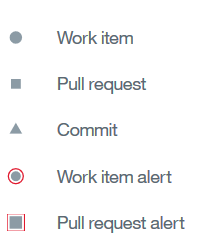
To see the default query defined for a stage, click the mouse on it and then click About this Stage on the pop-up that is displayed. The following graphic shows a pop-up for a stage called In Review that contains nine items (not shown).
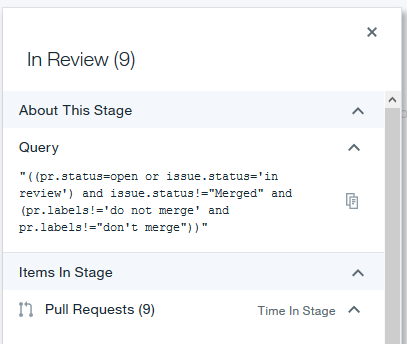
In addition to queries, you can apply other filters to the value stream. By default, when you open a value stream, items are filtered by type. An item's color indicates the type of item represented, such as a bug or epic. The Legend drop-down list describes what the colors represent, as shown in the following graphic:
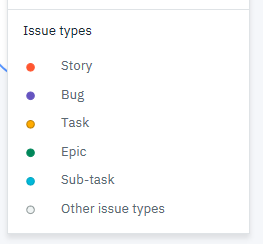
You can also filter items by release and priority. When you change the filter to Priority, for example, the items change color to the priority color scheme. The Legend drop-down changes to the priority color scheme, as shown in the following graphic:
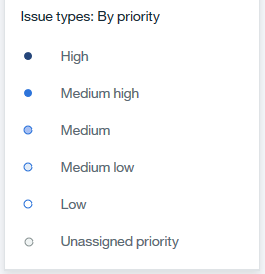
Searching in value stream data
Searching a dot in value stream data is possible in two ways, Plain text
search and Search with DQL
Plain text search is the free text search of the dot in the value stream. When search text is entered in Plain text search field, it displays all dots which are associated or contains the search text. Use Plain text search field to search the dots with issue id, issue labels, issue name, issue owner, issue priority (high, highest, low, lowest and medium), issue types (epic, story, sub-task, and task), releases, and sprints.
 .
.Understanding value stream data
Queries that set the value stream scope
are defined in the value-stream-name.json file. When you display a value stream,
items matching the preset queries are displayed. The following graphic displays a value stream with
items integrated from an issue tracking system and a source control system. Each stage has a query
defined for it that determines the items that are displayed in it. The In Progress stage has a query
defined for it similar to this one: "query": "issue.status=\"In Progress\" and
pr.status!=MERGED and pr.status!=closed".

In the above figure, you can view the value stream data filtered by the following: Type, Priority, Release, and Sprint.
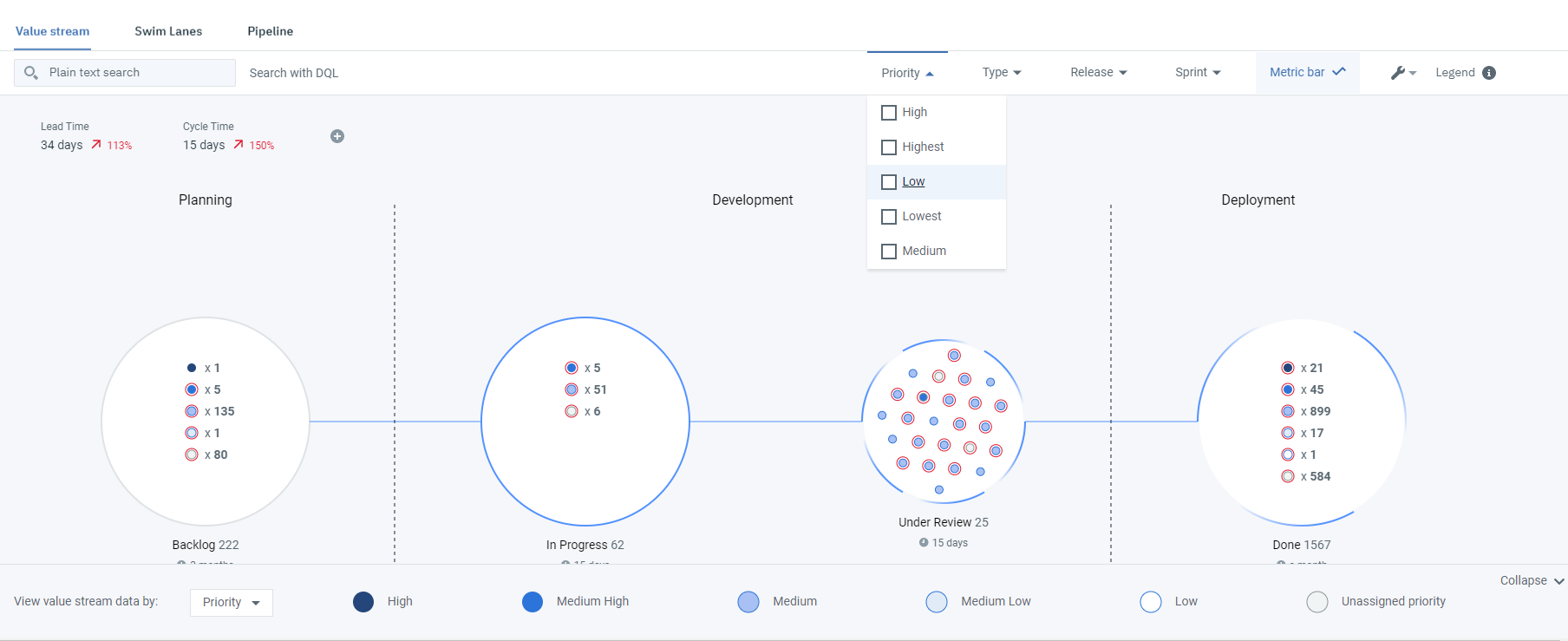
In the above figure, you can view the detailed value stream data by selecting the drop-down of Type, Priority, Release, and Sprint.
If a stage has more than 40 items, summary information replaces the individual items, as shown in the following graphic:
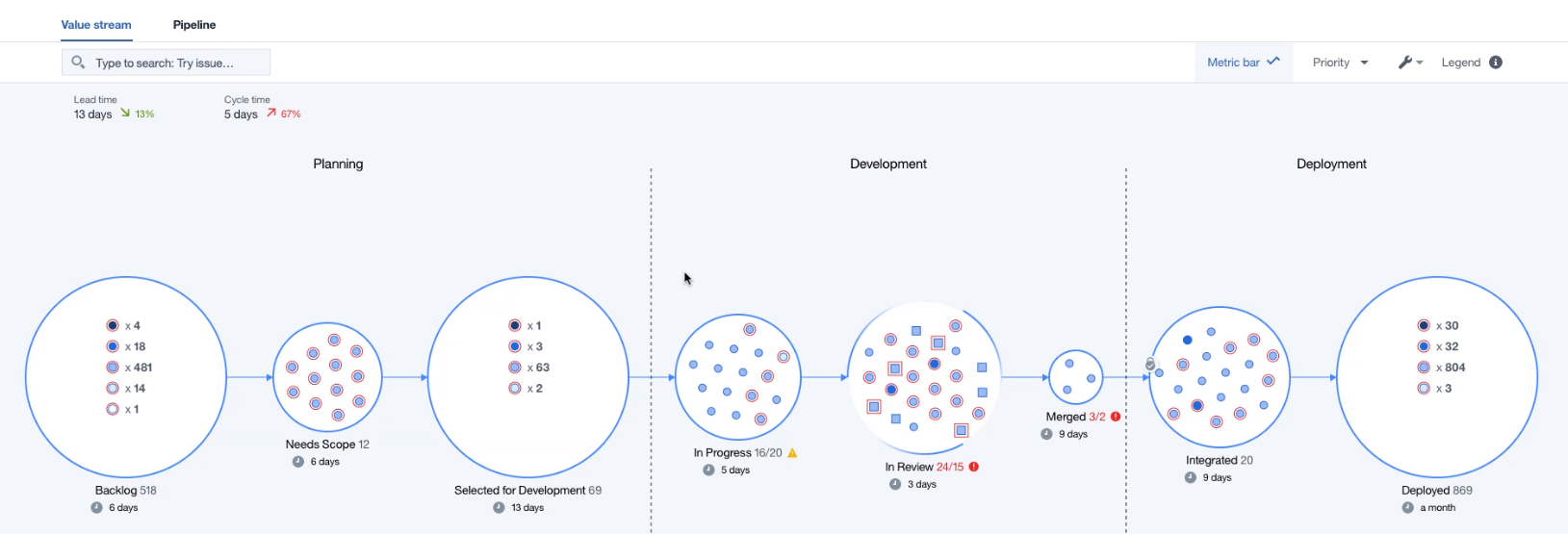
Value stream items
You can display information about the items in a stage. When you click an item, a card is displayed with information about the represented item, such as a Jira issue. Full history about the item is presented in context, including its history. You can use the supplied links to open the item in originating tool.
The following graphic displays a Jira issue in the value stream's In Progress stage. Links, highlighted in red in the graphic, can open the item in the integrated tool.
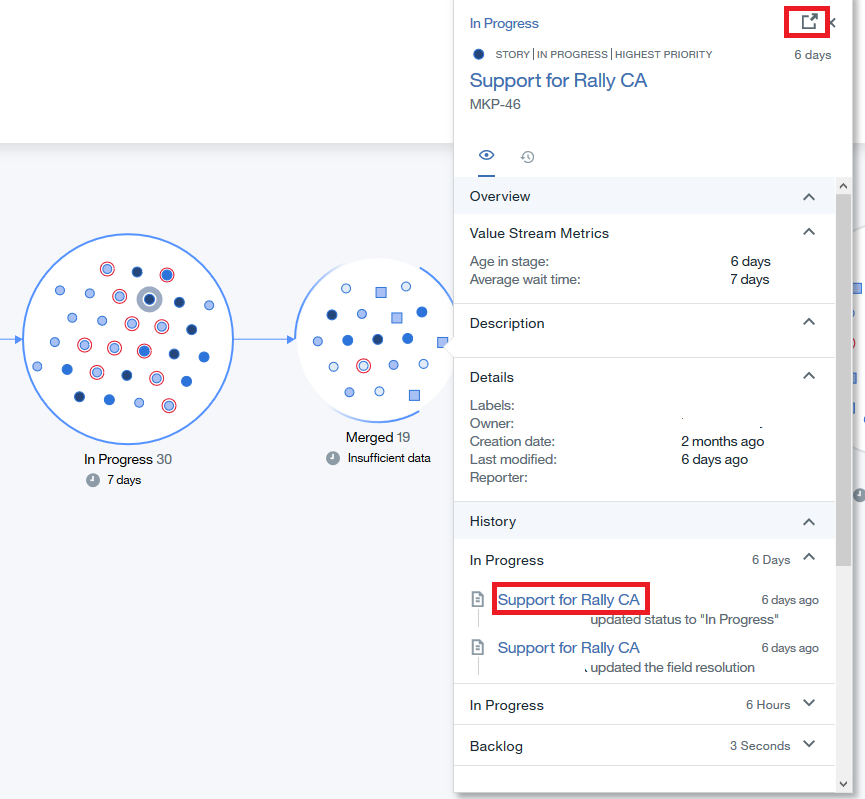
If linking rules are defined for the integrations, information from the linked tools and available. Link rules link two integrated tools, such as Git and Jira, to make information from both tools available in the affected items.